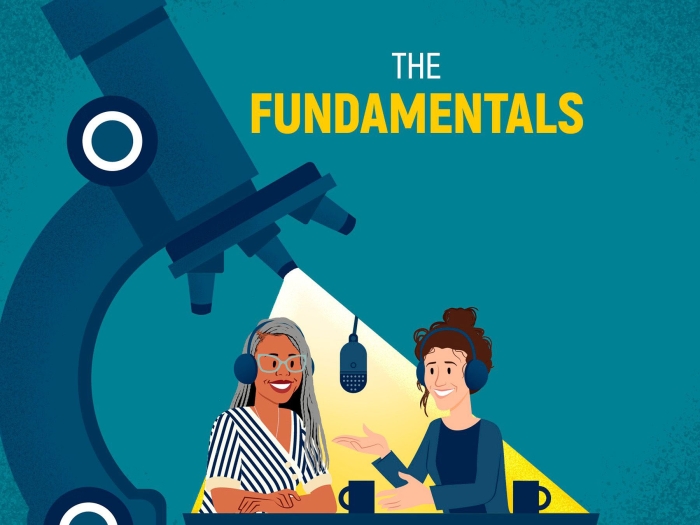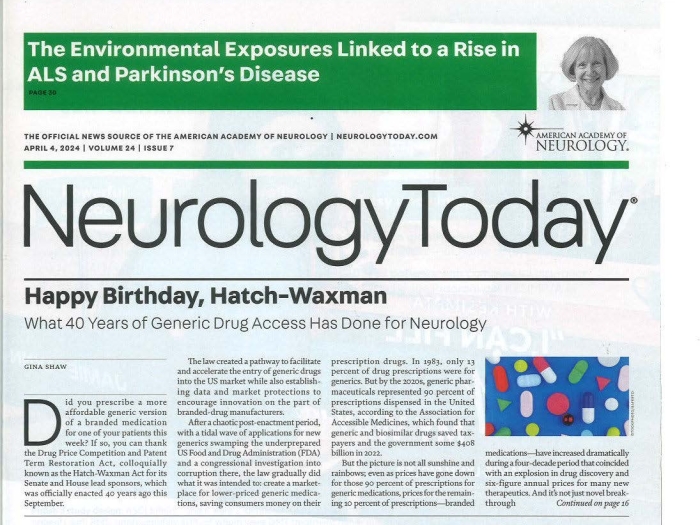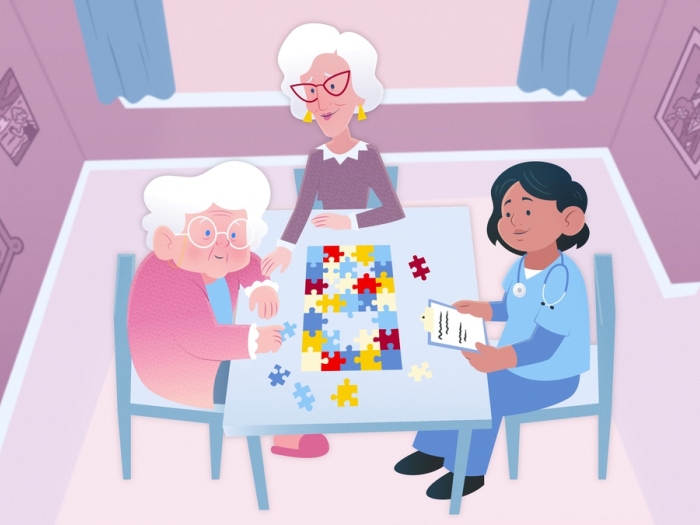Our guest in this episode is Dr. Sara Adar. She is an associate professor at the University of Michigan School of Public Health in the department of epidemiology. Dr. Adar was the senior author on a study titled “Long-term community noise exposure in relation to dementia, cognition, and cognitive decline in older adults” that was published in the journal Alzheimer’s & Dementia. The study used data from the Chicago Health and Aging Project to examine the association between exposure to community noise and cognitive impairment. We talk with her about how exposure to noise affects cognition.
Transcript
Matt Davis:
I've always thought the word environment was sort of interesting because it can depend on the context. For most people environment is synonymous with the natural world, which brings to mind issues regarding pollution and climate change that make us all depressed. To epidemiologists though, who study human exposure environment can apply to the physical and built environment, the work or occupational environment, social and cultural environments, et cetera.
Environment also makes me think about the interconnectedness of things. Now, any public health student will tell you that of course the things we come in contact with in our environment can influence our health. This is why we spend time thinking about the food we eat, the cleanliness of the water we drink, and the quality of the air that we breathe.
There are however, more insidious ways that our environment can impact health. I recall a study I read a long time ago that showed how nocturnal light pollution, presumably light coming in people's windows while they sleep may be related to breast cancer incidents.
In this episode we're going to discuss a paper that explored the relationship between exposure to community noise and cognitive functions. I'm Matt Davis.
Donovan Maust:
I'm Donovan Maust.
Matt Davis:
You're listening to Minding Memory. Today we're joined by Dr. Sara Adar. Dr. Adar is an associate professor at the University of Michigan School of Public Health in the department of epidemiology. She's an environmental epidemiologist whose research focuses primarily on the effects of air pollution. She's served in the past as an expert panelist for the Environmental Protection Agency and the World Health Organization, and she's received several notable research awards. She's here today to tell us about some of her recent work on noise exposure and dementia. Sara, thanks so much for joining us.
Dr. Sara Adar:
Yeah, thanks so much for having me. I'm really happy to be here.
Matt Davis:
Last year. Dr. Adar was the senior author on a study titled long-term community exposure in relation dementia, cognition and cognitive decline in older adults that was published in the journal Alzheimer's and Dementia. The study used data from the Chicago Health and Aging Project to examine the association between exposure to community noise and cognitive impairment.
For those of you who might not be familiar with the Chicago Health and Aging Project, it's a cohort study conducted by researchers at Rush University that includes approximately 10,000 older adults from several different neighborhoods in the Windy City.
I tell my students that it's important to read good studies. Once you stop having to take classes, reading articles is how you learn new things and how you get inspired. In my opinion, this is one of those studies. In addition to becoming aware of the findings, you're likely going to pick up a few other interesting things.
In full disclosure though, I've always been a bit of a geospatial analysis groupie. If you haven't read the article yet I strongly encourage you to take a look at it. Go ahead, pause the podcast, read the abstract we'll wait. To start things off, Sara, can you tell us a little bit about the current state of knowledge around community noise and human health?
Dr. Sara Adar:
Yeah. I think it's no surprise to any of us that noise impacts hearing. We all are accustomed to going to the really loud concerts or being near jackhammers and worrying about our ears and our hearing. Those of us who've lived near sources of noise know it can be hard to sleep and it disrupts your ability to communicate with others and your ability to concentrate, it can just be really annoying.
What's generally less appreciated certainly here in the United States, however, is that noise can cause stress in our bodies that actually induces much more subtle changes. For example, it can increase our blood pressure, which then can lead to higher risk of heart attacks and things like that. And now in this study, what we started to look at was whether or not noise exposures in our communities can also impact our brains.
Donovan Maust:
So is the idea that the relationship is sort of mediated through a stress response or is there something about the noise actually being directly neurotoxic itself?
Dr. Sara Adar:
I think that there's different hypotheses and we don't know the answer exactly, but I do think that the stress response is likely to be a dominant one here, as is I think sleep. I think that we're understanding more and more how disrupted and lack of sleep impacts dementia. And there's these cool theories about how the proteins shower away gunk in your brain as we rest. So, I think that those are two of some of the very plausible mechanism by which noise might impact the brain.
Donovan Maust:
A number of our listeners we hope at this point are familiar with some of the cognitive function measures used in these types of studies. You use some interesting methods though, as it estimate community noise level that people are probably less familiar with, including something called the universal kriging model that I have never heard of before. Can you tell us a little bit about how you went about estimating noise level, and are the methods that you used here sort of consistent with other types of work you've done before in this space?
Dr. Sara Adar:
Yeah, absolutely. Like many pollutants are an environment, noise levels can differ very dramatically by place. What that means is that, for example, if I live right up against a freeway my noise levels might be 100 times higher than what you would experience a few houses away or even a block away.
Now, noise levels are not random, as you might imagine, it's going to be based on what's near you. Airplanes, traffic, trains, bus stops, all those kind of things lead to noise in our environment. And so, what we did is that we went out and we did this really intensive sampling campaign where we tried to sample in all different places of the Chicago community. We sampled near and far from sources of noise. And then what we base basically did is we created the spatial prediction model that estimates long-term exposures to noise based on what's around you.
And so, yeah, it's called universal kriging. Effectively what that is, it's a pretty fancy sounding name, but it's basically a linear prediction model that you account for spatial correlation. And what I mean by that is that you can imagine that levels of noise are related to each other based on how close you are. So if someone's standing right next to me they're going to have noise that's very similar to me, whereas if someone's standing far away they'd have different.
So basically, the universal kriging model, which is something we use all the time in air pollution epidemiology just allows us to predict new noise levels at places that were not measured based on the characteristics around you and the correlation or information from neighboring measurements or places.
Donovan Maust:
Got you. If I recall, the study included four different neighborhoods in Chicago. To what extent do you think those neighborhoods are sort of representative of the sound environment that's out there? Is this generalizable?
Dr. Sara Adar:
It's a great question. So yeah, the CHAP study, which is what we affectionately call the study in Chicago was done in a more limited geographical space. It is primarily in one neighborhood, in South Chicago. Having been to that neighborhood and done this sampling with my graduate students, it looks a regular city environment, it's common for Chicago. Certainly that environment is going to differ than some other places though. For example, you can imagine standing in the middle of New York City, if you're in certain neighborhoods that might look different than, for example, this one in Chicago. Or even more extreme, if you stood in the middle of a field in Iowa that's going to look really different.
So, I do think that it was a fairly representative area in the city, but certainly I could imagine that the noise levels might differ from what you'd get in New York City, as well as the housing characteristics, and the same with being in a rural place.
Matt Davis:
I had a similar thought. I wondered whether you would get enough variability within one geographic area.
Dr. Sara Adar:
Yeah. It's a great question and certainly something we worried about because it was this one neighborhood. But it does come back to that amazing characteristic of noise, which is that it actually has an exponential decay from sources so that it does lead to this variation that if you have, again, a major roadway running through a neighborhood you're going to get a huge difference in exposure from those folks who are right up against the road as opposed to, again, a few blocks away. So that's sort of the wonderful thing from a study design perspective about noise is it does have that fine scale variation, which again, is why we need these sophisticated models to predict what those levels might be.
Matt Davis:
Is there an agreed upon level or decibel level or something that's too much noise or excessive that people... or not really?
Dr. Sara Adar:
Well, Europe has better standards than the United States. The United States used to be a leader in noise research until about the 1980s. And I've heard rumors as to which company was involved in putting some pressure on the government in terms of stopping noise research in the United State, I'm not sure I have that confirmed. But in the United States noise has not been a real priority pollutant for the government really since the '80s. So, we don't have standards here to protect us from the ambient levels, we just have the really extreme ones for occupational settings.
Donovan Maust:
Well, we'll have to ask you after the podcast what that company was, but we won't record your answer.
Dr. Sara Adar:
Sounds good to me.
Matt Davis:
It makes me wonder too about the quality of the noise, like noises from nature versus artificial must be different, in addition to just the overall level, you know?
Dr. Sara Adar:
Yeah. I had the wonderful experience of going on sabbatical a few years ago and I took with me some noise instruments. We lived in Seattle and my family drove 30 days across the country to Seattle and then back, we went to like nine national parks and had this amazing time. And me and my kids did noise sampling across the country, and you would be shocked at how loud some natural sources are.
In the middle of a natural... sorry. In the middle of a national park, if you're standing next to a waterfall levels can be extraordinarily loud. It's really interesting. But I do agree that that kind of noise I would expect would have a different response on our bodies than that train that's coming through episodically and blaring its horn.
Matt Davis:
Only a researcher would bring their kids in and experiment on vacation.
Dr. Sara Adar:
Oh my gosh, yeah. My family started getting sick of me because I would take these five minute noise samples anytime we stopped. It would be restroom break or gas break or lunch and I would be standing out there taking noise samples.
Matt Davis:
Let's talk a little bit about the data source. I think some of our listeners are going to be interested in this Chicago Health and Aging Project. Can you tell us a little bit about your experience working with those data and what you perceive as the strengths and the weaknesses?
Dr. Sara Adar:
Yeah. So of course, good science is always done when you have access to great resources and this CHAP study is one of those. It's great because it's a large study that was done for research. It collects detailed information on people and their cognition, where really they were collecting surveys of people's cognition every three years to test their cognitive functioning.
And that has the wonderful benefit that it's not just relying on medical records, which medical records sound good. But the trick about medical records is it's not just if you get dementia, but also if you're going to the doctor to even get diagnosed with dementia, which you can imagine to tracks pretty closely with socioeconomic status and noise tracks pretty closely with socioeconomic status. So having research-grade data was really important.
CHAP is also really nice because it includes a large fraction of African American participants as opposed to many studies which are really just focused on white individuals. That's another really nice feature of CHAP. In terms of weaknesses, we talked a little bit about it being a smaller geographic neighborhood in one city, sort of asking that question, Donovan, that you had about how much can I take these findings and apply them to anyone in the country is a question.
The other thing is just on studies of aging can be a little bit tricky because you wind up selecting the healthiest people to remain in your study over time. As you follow older folks for longer and longer you sort of get these healthier and healthier individuals as time progresses.
Matt Davis:
To what degree are the data actually accessible to researchers?
Dr. Sara Adar:
That's a great question. I had some collaborators who worked with CHAP, that was how I got access to the data, the PI was extremely welcoming. So it's not just publicly available where you can easily get it in hands or something like that, but once you have your IRB in place and you work with a PI, getting access was not problematic.
Donovan Maust:
So then really with any type of study in particular, I would think with this study you have to wonder about confounding related to other types of environmental exposures. I was wondering if you could talk a little bit about how you handled that in your analysis and this time I'm also especially interested in the neighborhood disorder score and if you could tell us a little bit about that.
Dr. Sara Adar:
Yeah, absolutely. As an environmental epidemiologist or epidemiologist in general we take confounding so very seriously because you always worry, "am I really looking at the exposure of interest or is it something else that might be confusing my association?" Typically, when we're in environmental field we worry most about socioeconomic status. In this design we adjusted for race, we adjusted for personal income and education level. And then as you mentioned, we also adjusted for some of these characteristics of your neighborhood, because there's really interesting research, especially in cardiovascular disease that shows it's not just about your own individual socioeconomic position that matters, but actually what resources there are around you that matter.
So for neighborhood socioeconomic status we used information from the census just to get a characterization of the type of people that are living there. We also had this neighborhood disorder score, which was based on self-reported information about neighborhood composition and really quality of the neighborhood around you. Thinking about things sidewalks and whether or not those have good conditions and other characteristics of your space.
Donovan Maust:
It seems like if you think about the noise pollution as sort of a ambient source of stress, this is almost another type of environmental stress that you're able to capture and account for.
Dr. Sara Adar:
Yeah, absolutely. And that's one of the reasons we were interested in including that in the models just to make sure that it wasn't, for example, exposure to violence that's tracking with the noise.
Donovan Maust:
Right.
Dr. Sara Adar:
That's also a really important source of stress in neighborhoods. I just wanted to mention the other things that we adjusted for in our model. If you were listening to the different kinds of sources of noise you might imagine that air pollution also tracks with many of those, and so we adjusted pretty carefully for air pollution levels at people's homes as well. And then also included sort of your standard risk factors of age, and sex, and time, and smoking, and alcohol use.
Matt Davis:
Let's turn to the results, what'd you find?
Dr. Sara Adar:
We found that living in a house that had higher neighborhood noise around it increased your odds of having mild cognitive impairment and dementia. We also found that those higher levels of noise was associated with worse cognitive performance, especially related to perceptual speed. And if you translate that into years of age it looked as if having a 10 decibel higher noise level, which maybe would be the equivalent of going from a quieter neighborhood to a more urban neighborhood with bustling and things like that was equivalent to the difference in cognitive function that you would see from two people who are two years apart in age.
Donovan Maust:
And then you also looked at particular subgroups of interests, did you find any particular notable differences in findings based on different populations of patients or participants?
Dr. Sara Adar:
Yeah, we did. We looked to see whether or not this association between noise and cognitive functioning differed by people of different ages and races. We actually had APOE to look at sort of a genetic risk factor for dementia and we also looked at this socioeconomic status in neighborhood disorder. I would say we found some limited evidence that there were differences by socioeconomic status with folks in lower socioeconomic status or more disordered neighborhood having a slightly higher risk and that might be due to different quality housing, interaction with other stressors or added stressors in those individuals' lives.
But I would say actually in looking at the results again, I think it's pretty largely consistent across groups, which to me is really important because it actually shows that this is a meaningful impact for everyone. It's not just one really susceptible group, this is something that's happening across the population in general.
Matt Davis:
Regarding the results, I just want to say that I really your table too. If you don't have the article in front of you, it's a super short table of two odds ratios. And I feel like I have these conversations with trainees all the time that people don't have to be big and huge, really, effective tables are really short and to the point. I have a question that's a little bit more into the weeds actually.
Dr. Sara Adar:
Okay.
Matt Davis:
When you think about dementia measures, you have things like immediate and delayed recall and all these different types of measures that have different scores, people turn those into Z-scores. And I've seen variation in how people then create global scores. From what I recall in your article, you decided to basically took the average of Z-scores and put them together. Do you have any thoughts about, I don't know, statistically, whether there's one preferred way versus the other versus just adding the Z-scores together?
Dr. Sara Adar:
It's a really good question and I will admit that I'm learning more and more about it every day. I work with somebody named Alden Gross who's a professor at Johns Hopkins on a different study and he's been doing some interesting approaches where effectively you allow different constructs to cluster together. So when you do this average Z-score, you sum the Z-scores or you do something like that, what you're effectively doing, and you likely know this, is you're assuming that each one of your tests has equal weight. And so you're just sort of adding them all up and everybody gets the same amount of impact on your total score.
And my impression of what is happening now and where the field is moving to is allowing things to weigh in on these different pieces and perhaps thinking about whether or not each of your tests should have equal weights. But again, that's less of my area of expertise, but I do see that there's pretty interesting research going on in that area.
Matt Davis:
In the article it mentions that there hasn't been a lot done, particularly in the United States, looking at noise level and cognitive function. How do you see the results from your study kind of fitting in?
Dr. Sara Adar:
Right. There's been relatively little studied on this association between noise and cognition. As you mentioned, there's a few studies from Europe. Our results are generally consistent with findings from studies in Germany and in London, in the UK, less so from a study in Sweden where the levels were really low. And now in the United States actually about the time that we published our research or shortly after there was a new study that was done in the Sacramento area by a colleague of mine. And there they found almost identical associations between noise and incident dementia and MCI, mild cognitive impairment as we did in this study. I think in general our results are consistent with the limited research that we're seeing.
In terms of fitting in from a different perspective, I think that the US has largely ignored noise as an important source of poor health in our nation for a while now. And so I think what's important about this study is not just advancing the science of this topic, which does need more research, but I think doing a study in the United States is important to really shine a light on this issue.
A friend of mine did a study a while back already now and showed that it was something like 50% of our urban populations were living at levels that the WHO would've called unsafe for noise and yet it's not something that's on the general population's mind as something to worry about. So again, I think our studies are largely consistent with what's been seen in the few other papers out there, and I think it's important that we're doing this research here.
Donovan Maust:
I think we clearly have a lot more to learn about how the environment impacts our cognitive function. So what do you see as promising future directions of work based on your work so far?
Dr. Sara Adar:
I think one of the positive things about this research, again, is that it's going to highlight noise as a potential toxicant to us here in the United States and impacts on our health. In general, I think there's been a really big push on environmental exposures and dementia in recent years with the funding for this through the NIH. And so air pollution really has seen an explosion in our understanding that it is a risk factor for dementia and poor cognitive impairment.
And I think it's important because many individual level risk factors and interventions have largely been ineffective at stopping the progression of dementia and improving the number of people from getting dementia. And so these kind of factors are exciting because you can modify them on the population level. With air pollution we have the Clean Air Act, we've seen great improvements in health with the Clean Air Act. And now thinking about how this might improve and prevent people from getting dementia is great. If similar actions could be done with noise, I think that would also be really exciting.
In terms of other sort of interesting research that's going on and thinking about what we can do next, I think that for me it would be really interesting thing to think about sources of resilience to some of these environmental exposures. Maybe in the next studies we can look, for example, at whether or not people who live near major roads but who have a sound barrier might not have the same kind of impact of living near a highway as people who don't have that sound barrier. Could it be that trees, for example, provide protection? We know that building types and better window panes and things like that can improve people's noise exposures. Thinking about that would be interesting.
And just in other topics, my research area, as you noted at the beginning is also in air pollution. And we've been doing a lot of work on air pollution and dementia now around the world, so we have studies that are spanning now from India, and China, Mexico, the United States. And thinking about the similarities in those associations and the differences, and thinking about how, for example, indoor exposures, so people are still using biomass fuel for cooking, can impact our brains. It's not something we perhaps worry as much about in the United States, but from a global health perspective it's a huge burden for dementia and cognitive decline.
Donovan Maust:
So it sounds like you'll have no trouble keeping busy.
Dr. Sara Adar:
Yes. I am grateful for interesting things to study, and wonderful studies and collaborators to do that with.
Matt Davis:
It makes me wonder how electric cars will perhaps change some of these noise levels on roads.
Dr. Sara Adar:
Oh, yeah. Because like I said, I study air pollution as well as electric cars are fascinating because from an air pollution perspective yes, the air pollution levels are lower with electric cars, but you need to make that electricity. So how you make the electricity has a huge impact on the population burden of electric cars. Luckily we're moving towards cleaner energy sources, but if you were just burning coal to fuel those, that would be a situation.
But from noise, it's really interesting because sort of the opposite trends with... air pollution and noise sometimes from vehicles do the opposite. In a traffic jam you get more air pollution, but less noise because the cars are still, and it's the sound of the tires that often make noise from roads. So electric vehicles would probably impact our air pollution but maybe less than noise.
Matt Davis:
So I'm going to think twice before I buy a house underneath a waterfall. Sara, thanks so much for joining us, and thanks to all of you who listened in. [00:30:30] If you enjoyed our discussion today please consider subscribing to our podcast. Other episodes can be found on Apple Podcasts, Spotify, and SoundCloud, as well as directly from us at capra.med.umich.edu where a full transcript of this episode is also available. On our website you'll also find links to our seminar series and the data products we've created for dementia research.
Music and engineering for this podcast was provided by Dan Langa, more information available at www.danlanga.com. Minding Memory is part of the Michigan Medicine Podcast Network, find more shows at uofmhealth.org/podcast. Support for this podcast comes from the National Institute on Aging at the National Institutes of Health, as well as the Institute for Healthcare Policy and Innovation at the University of Michigan. The views expressed in this podcast do not necessarily represent the views of the NIH or the University of Michigan.
Thanks for joining us. And we'll be back soon.

Listen to more Minding Memory podcasts - a part of the Michigan Medicine Podcast Network.





